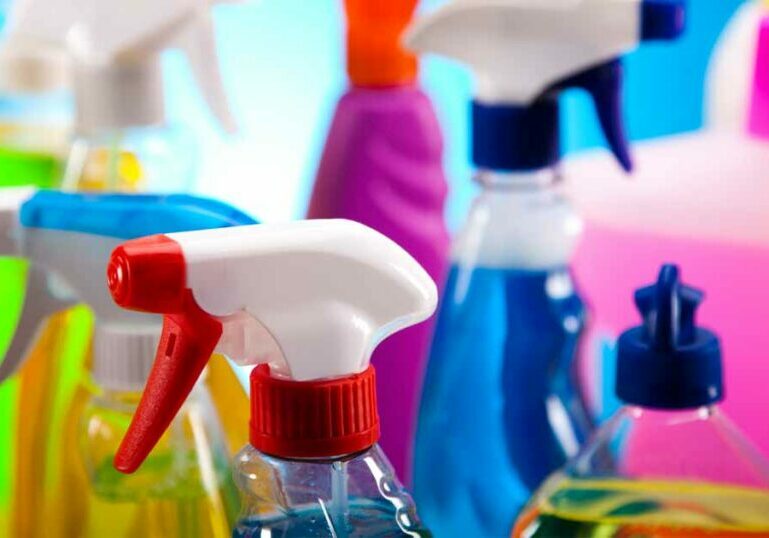Sensible measures enough to prevent the spread of disease
Exaggerated fears of infectious diseases spreading in schools are leading to the overuse and misuse of toxic chemicals for cleaning. The truth is that schools can be cleaned perfectly adequately without strong chemicals. Yet dozens are routinely used, including solvents, acids, and caustics.
Disinfectants like chlorine, phenol, and quaternary ammonium compounds are often added to the toxic mix. These products have health effects ranging from headaches and dizziness to cancer and asthma. It’s not surprising that custodians have one of the highest work-related asthma rates among all workers and that chemical burns represent 20 percent of reported injuries to custodial workers.
Infectious diseases are spread primarily through the air, contaminated surfaces, and direct person-toperson contact. Their spread is best prevented through nontoxic cleaning and other sensible measures such as proper operation and maintenance of ventilation systems and windows, and policies that encourage sick staff and students to stay home when they are contagious, wash hands frequently, cover coughs and sneezes, and bandage wounds.
School districts are often unaware of the differences between cleaning, sanitizing, and disinfecting. As a result, they may have custodians cleaning with disinfectants instead of detergents.
Parents are often erroneously encouraged to donate disinfectant wipes for classroom use. Many people think these wipes can be used on the hands and face but they contain toxic
EPA-registered pesticides only meant for use on hard, non-porous surfaces. Disinfectant overuse contributes to exposure to staff and students as well as development of resistant microbes.
Limit who can clean schools
Misplaced zeal about disease prevention has noncustodial staff being enlisted to clean and disinfect their work areas. The local association should negotiate restrictions on who can clean. This will minimize the number of staff who directly use products and are at risk for breathing in toxic ingredients or getting them on their skin or in their eyes. Limited cleaning may be appropriate in the normal performance of their jobs by food service workers and bus drivers, but teachers and paraeducators should not have to clean desks and more. In incidents involving blood or other body fluids, cleaning and disinfection must be performed by a properly trained custodian wearing splash goggles and gloves.
Champion better ways to clean schools
Manufacturers have reformulated their products and labeled them with terms such as “environmentally safe,” “green,” and “nontoxic.” Some of these claims are valid. Some are not. Different groups use different criteria for what is “green.” Therefore buyers need to be informed. Local associations can play a role in encouraging school districts to choose products that are rated “green” by independent, nonprofit organizations.
The need for chemical cleaners can be minimized and the efficiency of custodians maximized by the use of modern cleaning equipment, including:
- Microfiber mops, cloths, and dusters
- High-filtration HEPA vacuums and vacuum attachments
- Floor care equipment with stripping pads
- Walk-behind hard floor auto-scrubbers
- Hands-free mops
- Chemical-free systems such as steam vapor devices
Walk-off mats to prevent dirt, pesticides and other debris from being tracked into and throughout the facility are also a good way to reduce the need for chemical products. There should be mats inside and outside every entryway. They should be as wide as the doorway, 15 feet long, and vacuumed daily. Sidewalks outside doorways should be swept daily.
Local association action plan
Local associations should work with their UniServ field representatives to ensure that districts put these healthy cleaning policies in place with meaningful input from association members and custodians.
- Formal training of custodians in cleaning protocols; chemical product hazards; handling, measuring, mixing, and storing of chemicals; and protective equipment.
- Minimal cleaning and sanitizing and no disinfecting performed by noncustodial staff.
- Use of certified least-toxic products. No uncertified products brought in by staff or donated.
- Modern cleaning equipment and walk-off mats.
- No aerosol cans or fogging. Pump bottles used on stream setting, not spray, so less will get in the air or apply small amounts with a cloth.
- Wet paper towels or baby or wet wipes instead of disinfecting wipes.
- Written protocols for cleaning that distinguish between cleaning, sanitizing, and disinfecting and specify when, where, how, how often, and by whom each will be performed.
- Written job descriptions for custodians.
- Enough custodians: One full-time custodian for every 10,000 to 15,000 square feet of school floor area is a good goal.
- Operation of ventilation systems during cleaning. Heavy-duty cleaning such as floor stripping only when schools are not occupied.
